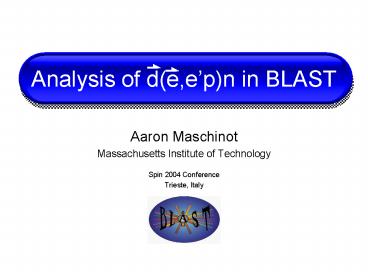Analysis of de,epn in BLAST - PowerPoint PPT Presentation
1 / 16
Title:
Analysis of de,epn in BLAST
Description:
Loosely-bound deuterium readily breaks up electromagnetically into two nucleons. e d e' p n ... Bates Large Acceptance Spectrometer Toroid ... – PowerPoint PPT presentation
Number of Views:38
Avg rating:3.0/5.0
Title: Analysis of de,epn in BLAST
1
Analysis of d(e,ep)n in BLAST
- Aaron Maschinot
- Massachusetts Institute of Technology
- Spin 2004 Conference
- Trieste, Italy
2
Deuteron Electro-disintegration
- Loosely-bound deuterium readily breaks up
electromagnetically into two nucleons - e d ? e p n
- Most generally, the d(e,eN)N cross section can
be written as - In the Born approximation,
- Additionally, vanishes in the L 0 model
for the deuteron (i.e. no L 2 admixture) - is a good measure of L 2 component
- Also, is also a good measure of L 2 as
well as subnuclear degrees of freedom (e.g. MEC,
IC, RC)
3
The BLAST Program
- Bates Large Acceptance Spectrometer Toroid
- Located at the MIT-Bates Linear Accelerator
Facility in Massachusetts, USA - Utilizes polarized beam and polarized targets
- 0.850GeV longitudinally polarized electron beam
- polarized internal atomic beam source (ABS)
target - Large acceptance, left-right symmetric
spectrometer detector - simultaneous parallel/perpendicular,
in-plane/out-of-plane asymmetry measurements - Toroidal magnetic field
- Ideally suited for a comprehensive analysis of
the spin-dependent electromagnetic response of
few-body nuclei at momentum transfers up to 1GeV2
4
Polarized Beam at Bates
- 1GeV longitudinally polarized electron beam
- 0.5GeV linear accelerator with recirculator
- Polarized beam fills South Hall storage ring
- location of BLAST experiment
- Longitudinal polarization maintained by Siberian
snakes - 25 minute lifetime _at_ 175mA ring current
5
Beam Polarization Measurements
- Beam polarization measured via a Compton
polarimeter - polarization amount of back-scattered photons
- nondestructive measurement of polarization
- Long-term beam polarization stability
- average beam polarization 65 4
PRELIMINARY
6
The BLAST Targets
- Internal Atomic Beam Source (ABS) target
- Hydrogen and Deuterium gas targets
- Can quickly switch between polarization states
- Hydrogen polarization in two-state mode
- Vector Pz ? -Pz
- Deuterium polarization in tri-state mode
- (Vector, Tensor)
- (-Pz, Pzz) ( Pz, Pzz)
- (0, -2Pzz)
- Flow 2.2 ? 1016 atoms/s,
Density 6.0 ? 1013 atoms/cm2,
Luminosity 4.0 ? 1031
/cm2/s _at_ 140mA - Actual polarization magnitudes from data analysis
- 3He target ready for future running
7
The BLAST Spectrometer
- Left-right symmetric detector
- simultaneous parallel and perpendicular asymmetry
determination - Large acceptance
- covers 0.1GeV2 Q2 1GeV2
- out-of-plane measurements
- DRIFT CHAMBERS
- momentum determination, particle identification
- CERENKOV COUNTERS
- electron/pion discrimination
- SCINTILLATORS
- TOF, particle identification
- NEUTRON COUNTERS
- neutron determination
- MAGNETIC COILS
- 4.5kG toroidal field
BEAM
DRIFT CHAMBERS
TARGET
CERENKOV COUNTERS
BEAM
NEUTRON COUNTERS
SCINTILLATORS
8
Drift Chambers
- Three wire chambers on either side
- Two superlayers of cells per chamber
- Three sense wires per cell
- 3 ? 2 ? 3 18 hit wires for ionizing particle
- 954 total sense wires, 9888 total wires
- Large acceptance
- 20 ? 80 ,
- -17 ? 17
- 1sr total solid angle
- Each wire 98 efficient
9
Event Reconstruction
- C OOP reconstruction library using ROOT
- Resolutions are a work in progress
- much progress has been made in the last six
months
.
10
Missing Mass and Momentum
- Only the e- and p are measured
- actually measure d(e,ep)X
- need cuts to ensure that X n
- Define missing energy, momentum, and mass
- Demanding that mM mn helps ensure that X n
11
Monte Carlo d(e,ep)n Asymmetries
- Using theoretical model from H. Arenhövel
- Data take into account detector acceptance
- Target polarization vector, ,set at 32º on
the left side - can access different asymmetry components
12
Background Contributions
- Empty target runs provide a measure of background
- Negligible contribution at small pM
- Larger contribution at high pM due to scattering
off of Aluminum target
Perpendicular
Parallel
13
Beam-Vector Asymmetry Results
- 200kC of data analyzed so far
- 450kC projected total data
- Vector polarization determined from fitting
asymmetry below pM 0.15GeV - Visible correlation with full subnuclear-effects
model
14
Tensor Asymmetry Results
- Tensor polarization from independent T20 fit
- L2 dips reproducible in the data
- Still working on systematic checks results are
preliminary
15
Determining the Vector Polarization
- In the quasi-elastic (QE) limit, d(e,ep)n is
well understood - reduces to p(e,ep) with spectator n
- lt1 model uncertainty in
- Large asymmetry, high detector efficiency ? small
statistical uncertainty - QE d(e,ep)n ? pM ? pN 0
- small uncertainty up to pM 0.15GeV
16
Conclusions
- Both the d(e,ep)n beam-vector and tensor
asymmetries are good measures of the L 2
deuterium component. - The d(e,ep)n beam-vector asymmetry is a good
measure of subnuclear effects (and relativistic
corrections). - Both asymmetries are being measured in BLAST
- Final asymmetry results with 450kC expected
within six months - Results will offer much discerning power between
models































